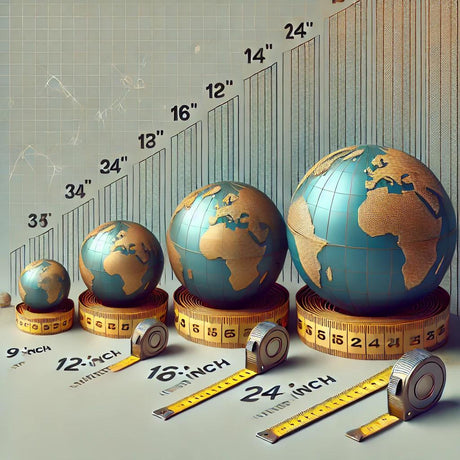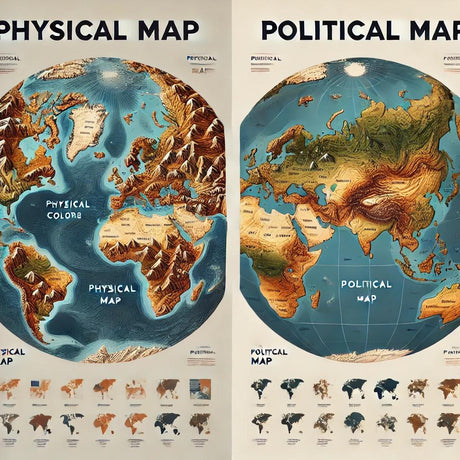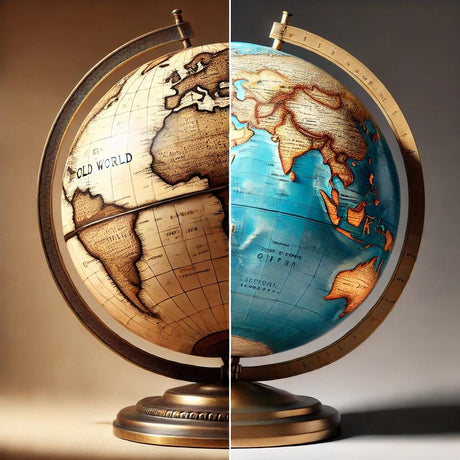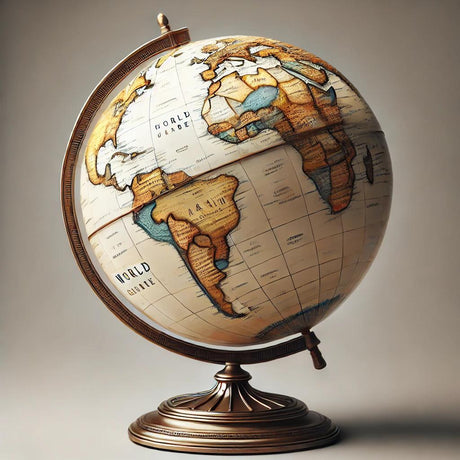In this article, we have compiled a list of terms generally associated with world globes. They may reference parts of a globe, a globe's manufacturing process, general geographic references, and much more.
This list has been created for our customers to better understand the references we make throughout our site, so that they can make the most informed decision when buying their next globe.
Analemma
The analemma is a figure 8 looking graphic commonly printed on older globes, usually in the eastern Pacific Ocean. The analemma is used for making calculations of mean time, acting as a reference point for the earth's tilt. The analemma also marks the solstices and equinoxes.
Armillary Sphere
A globe characterized by rings that indicate planetary orbits, zodiac constellations, celestial measurement circles, and the equator. Often mounted as garden sundials or with an orrery inside.
Axis
The axis is the rod or shaft at the center of the globe. It represents the imaginary line around which the earth rotates or spins. At the two ends of the axis are the North Pole at the top and the South Pole at the bottom.
Calotte (Polar Calottes)
More often seen in European globes, polar calottes are two round pieces of paper that cover the poles instead of paper gores.
Cartouche
The cartouche is the label on the globe that identifies the manufacturer and its location, and sometimes the model and manufacturing date of the globe.
Celestial Globe
Celestial globes are mounted spheres that show the positions of celestial bodies in the sky (e.g. stars and zodiacs).
Cradle Mount
The cradle mount is a type of mount that allows the globe to be disengaged for closer viewing. The globe is cradled and, as such, has no axis.
Degree
A unit of measurement used in globes, known as 1/360th of the circumference of a circle.
Diameter
A line that passes through the globe's center, measuring the diameter.
Eastern Hemisphere
The half of the earth generally recognized as being composed of Europe, Africa, Asia, Australia, and their nearby oceans.
Equator
The great imaginary circle that runs around the earth precisely between the poles, effectively dividing the world into the Northern and Southern Hemispheres.
Equatorial Band
The band applied to the equator, working also to cover the seam of the globe.
Equinoxes
The two events of the year, often around March 21 and September 23, when the sun’s rays are perpendicular to the Equator, resulting in day and night being of equal length all over the world.
Globe
The truest representation of the Earth; a map imprinted on an orb/round ball in the shape of the earth.
Greenwich Meridian
Also referred to as the Prime Meridian
Grid
It is the network of parallels and meridians on a globe.
Hemisphere
Any of the halves on the earth's surface (i.e. Northern hemisphere, Southern hemisphere, Western hemisphere, Eastern hemisphere)
Horizon Band
The ring attached to many globes. This ring represents the celestial horizon, which divides the globe into the hemispheres.
Inclination of the Earth’s Axis
Also known as the earth's axis tilt of 23.5 degrees. The tilt of the Earth's axis, which is angled at 23.5 degrees in relation to its orbital plane.
International Coloring Scheme
It is the system of contour layer coloring for showing elevation on globes and maps. Green represents lower elevations, yellow represents medium elevations, and orange and brown represent extreme elevations.
International Date Line
The imaginary line used as a reference to determine the beginning and end of the day. While arbitrary variations exist for local convenience, it follows the 180th meridian.
Latitude & Longitude
Latitude and longitude are horizontal and vertical lines that crisscross each other on maps and globes, helping establish reference points and creating a navigation system. Combined, these lines form a grid.
Latitude
Represented by horizontal lines on globes, with the equator being the middle-most line. All points north of the equator are called north latitude, while lines south of the equator are called south latitude. Latitude also identifies zones such as the tropical and arctic zones.
Legend
A reference that identifies symbols and details on globes and maps like railways, flight routes, and more.
Longitude
Represented by vertical lines on globes, with the prime meridian found at 0 degrees. All meridians to the left and right are west and east respectively, and are in 15-degree intervals.
Meridian
The metal band that encircles half or the entire globe, normally attached to the globe on both poles and the base.
Mounting
The structure to which the globe is attached and is what keeps the globe in place. See the definition of the many types of mounts (Plain Mount, Cradle mount, Stationary mount).
Northern Hemisphere
The half of the world's surface situated north of the Equator.
Orb
Another word used for globe, sphere, or round ball.
Overlay
The cartouche's overlay, or when a label is applied to cover the original cartouche.
Parallels of Latitude
East-west lateral lines around the globe that are parallel to the Equator.
Plain Mount
A globe mounted onto its base with no form of meridian present. A globe mounted onto the base without any form of meridian.
Prime Meridian (Greenwich Time)
Also known as the zero meridian, the basis of measurement for east and west longitude. The Prime Meridian (0 degrees longitude) runs through Greenwich and is the basis from which standard times are calculated.
Rotation
The earth’s turning on its axis.
Scale
The numerical relationship between an actual distance on the earth and the distance which represents it on a map.
Solstices
Either of the two points on the ecliptic at which its distance from the celestial equator is greatest and which is reached by the sun each year about June 22 and December 22.
Southern Hemisphere
The half of the world's surface situated south of the Equator.
Sphere
Another word used for globe, orb, or round ball.
Stationary Mount
A type of mount that keeps the sphere and full meridian affixed to the globe's base.
Time Dial
Commonly found on most 20th-century US globes, a time dial is a thin metal circle at the top of the globe. It is divided into 24 parts and is engraved or printed with the hours of day and night. It allows viewers to calculate the difference in time between the different time zones on the globe.
Western Hemisphere
The half of the earth generally recognized as being composed of North America and South America.
Zodiac
An imaginary belt in the nighttime sky and divided into 12 parts, each section represented by a symbol of a constellation.
Now that you know the way in which we reference our products and their features, start your shopping now to find just the right globe.




